Since 2018, Jinkosolar has been committed to research into and development of bifacial technology. In 2019, the company launched the Swan bifacial module with transparent backsheet, which won the 2019 Intersolar award as the only module product with innovative technology, excellent performance and forward-looking product design. Up to now, total orders for Swan bifacial modules have reached nearly 2GW. In addition, Jinkosolar has carried out field test projects all over the world, co-operating with PVEL, the Chinese Academy of Sciences, NexTracker and other third parties to study the power generation performance of bifacial modules and factors affecting bifacial gains, to provide reference and suggestions for customers designing bifacial power stations.
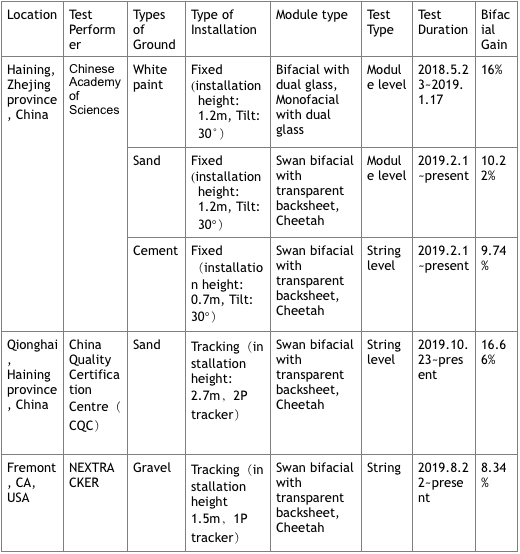
- Project Location: Haining, Zhejiang, China
1. Bifacial gain on white paint
The data gathered through May 23 2018 to January 17 2019 provides measured energy output of Jinkosolar’s bifacial module with dual glass (156mm size cell) and monofacial modules. The average bifacial gain is about 16% during the whole testing period, while higher in summer (up to 19%) and lower in winter.
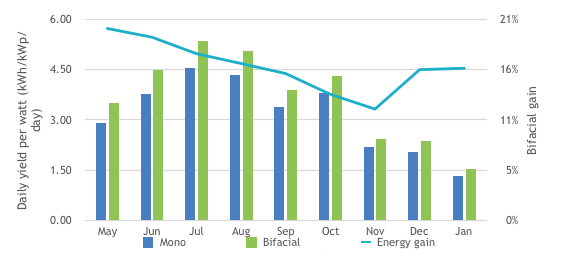
2.Bifacial Gain on Sand
The Swan bifacial module with transparent backsheet reaches a bifacial gain of 10.02%, with the same variation between seasons that is a little bit higher in summer, lower in winter.
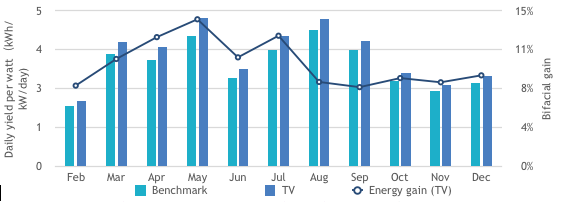
3.Bifacial Gain on Cement
This string type test on a cement surface was performed on Jinkosolar’s factory rooftop. The system was designed to be similar to a C&I project, adopting horizontal installation. The lowest point of modules is 0.7m off the ground. The average bifacial gain of the Swan with transparent backsheet is 9.74%. Bifacial modules show better low-irradiance performance. As irradiance becomes lower, the energy generation per watt also becomes lower but, conversely, bifacial gains increase.
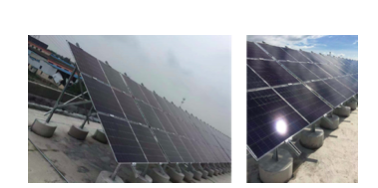
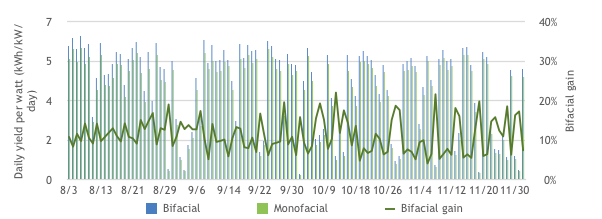
- Project Location: Qiong Hai, Hainan, China
Qionghai, located in the southernmost Hainan province of China, has a humid tropical climate featuring high temperatures and high humidity across the year. Modules were mounted in a 2P tracker configuration (two-in-portrait). Module height (flatwise) is 2.7m. The ground type is sand, albedo 19%-20%. The bifacial gain of the P type Swan TB module is significantly higher, up to 16.66% against the Cheetah monofacial module mounted on the same scenario. This high bifacial gain can effectively cut down LCOE.
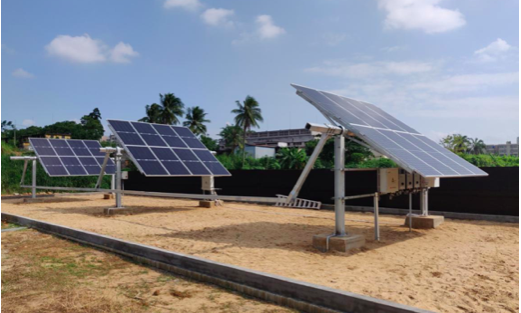
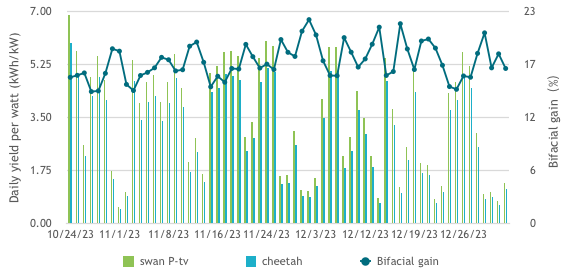
- Project Location: Fremont, CA, USA
Fremont, located in California on the west coast of the United States, has a Mediterranean climate with dry and warm summers as well as wet and rainy winters. The project is located in the outdoor field test station of NexTracker. The ground is light grey gravel, and the measured albedo of the site is around 20%. The bifacial gain of the transparent backsheet module is 8.34%. Considering the control group is made up of monofacial modules installed on the same tracker and ground albedo is 20%, a bifacial gain of 8.34% is significant.
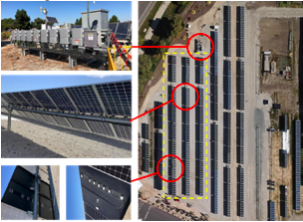
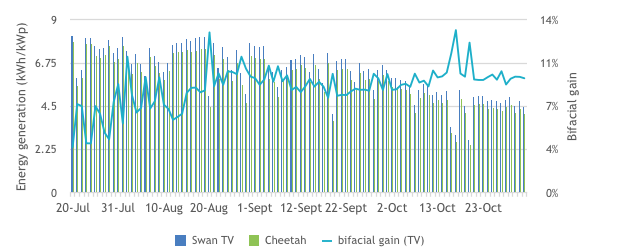
- Conclusion:
This white paper presents a summary of the results obtained from three bifacial and monofacial comparison tests, performed in different climates, over various ground types and deploying different mounting systems. The results reveal that the Swan bifacial module exhibits a high bifacial gain under different scenarios. They also provide points of reference and key factors for customers to consider when designing bifacial systems.
In a C&I project, applying fixed-mount and white paint ground with high albedo (80% – 90%) can ensure a bifacial gain of more than 16%, so that the same power generation can be realized with fewer modules and less initial investment, reducing the LCOE of the project. On the other hand, the transparent backsheet product is light and highly efficient, providing higher reliability and safety for a roof-top project. Using ordinary cement ground can also achieve a bifacial gain of more than 9%, without the additional cost of ground laying.
In the scenario of a large-scale power station, bifacial modules are always adopted with a tracking system. When the albedo is only 20%, besides the energy gain from the tracker, the modules provide another 8% in energy generation, effectively reducing LCOE. Bifacial modules with a tracker therefore represent the best option for large-scale station developers.
In Qionghai, where the irradiance conditions are poor, the Swan bifacial module with transparent backsheet ensures more power generation with excellent low-irradiance performance, lower operating temperature and remarkable outdoor reliability. With a 2p tracker, the bifacial gain can be as high as 16.6%, thus effectively reducing the LCOE of a project.
